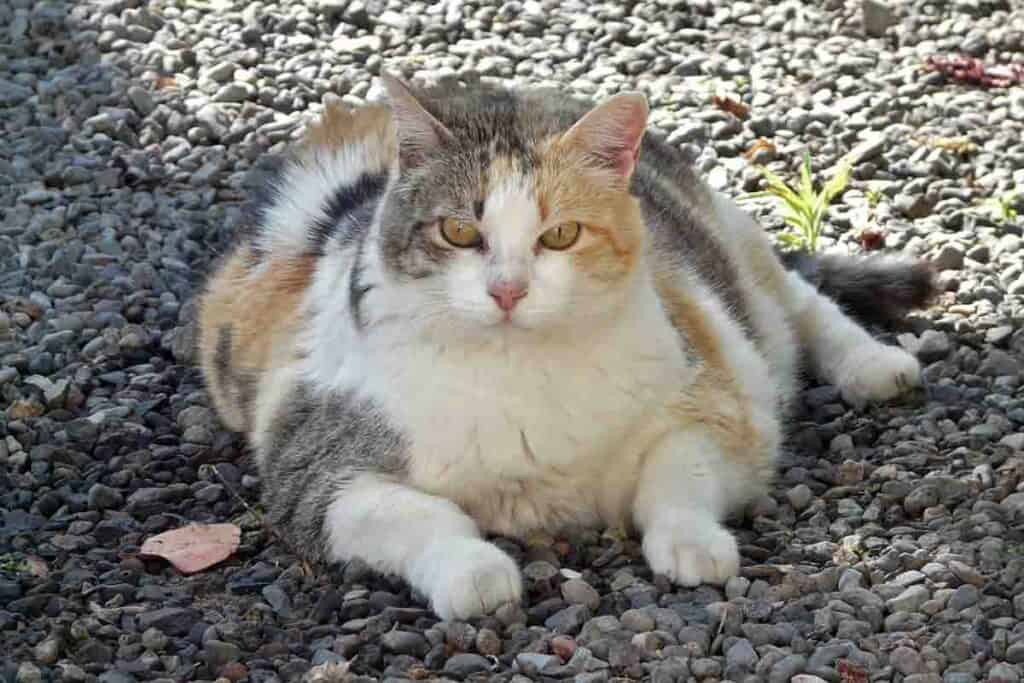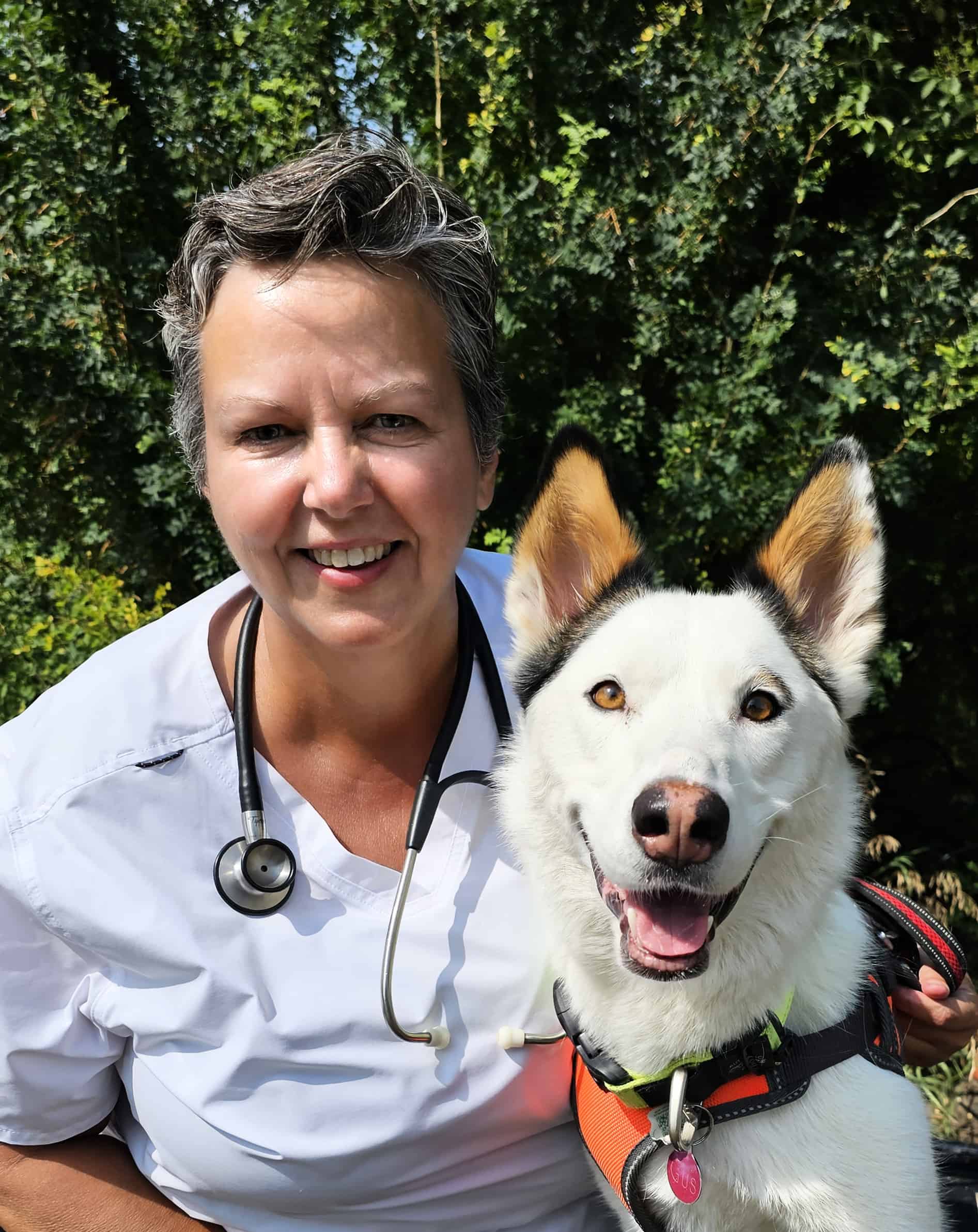Last Updated on May 1, 2023 by Dr. Wendy Wilkins, DVM, PhD
As owners of cats, it makes us happy to see our feline companions happy and healthy. Our goal is to ensure that they receive top-quality care, which includes feeding them with nutritious food and showering them with ample love and attention.
Sometimes, though, we feed our cats too well. Cats can also become overweight like humans, which can cause a range of health problems. How can you determine if your cat is overweight, and how can you assist them in maintaining a healthy weight?
Cat weight is not assessed based on weight alone due to factors such as breed, gender, and age. A better way to assess a cat’s weight is to use body condition scores, which are based on the feel and appearance of the cat’s body. Cats with a body condition score higher than 6 out of 9 are overweight.
In this blog post, we’ll explore the signs of feline obesity, the risks associated with it, and some tips for managing your cat’s weight to ensure they live a long and healthy life. So let’s get started!
What Is A Healthy Weight For Cats?
The ideal weight for a cat depends on several factors, including breed, age, and gender.
For example, large breed cats like Maine Coons can easily reach 20 lbs or more and still be a perfectly healthy weight.
On the other hand, a 20 lb Sphynx cat would be morbidly obese!
Age can also play a role. Younger cats are generally more active than older cats, and are more likely to be leaner than their older counterparts.
Gender can also have an effect on a cat’s ideal weight—male cats are typically larger than females.
The take-home message here is that we cannot just rely on weight alone to determine if our cats are a “healthy” weight.
How Can You Tell If Your Cat is Overweight?
In general, a healthy weight for a cat is one where they have a body condition score (BCS) of 4-5 on a 9-point scale. To assess your cat’s body condition score (BCS), refer to this chart that illustrates the shape and size of cats with different BCS.
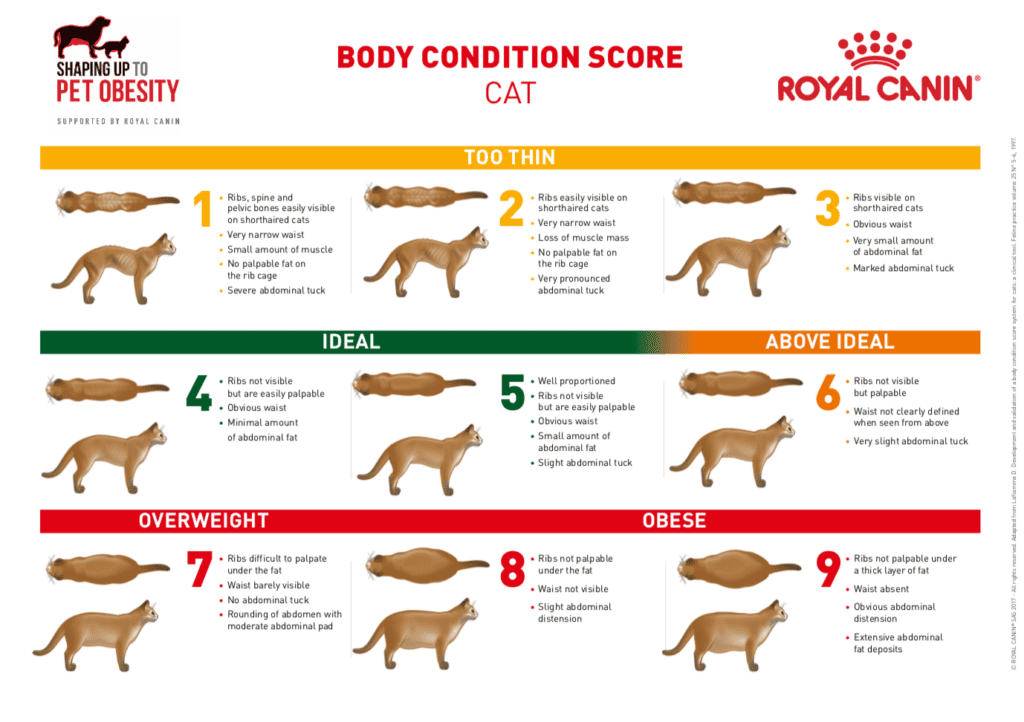
BCS 1-3: Too Thin
There is no mistaking a cat with BCS of 1-3 as being overweight! These cats are underweight, perhaps even dangerously so.
Cats in this weight category have ribs, spine, and pelvic bones that are are easily visible, and there is no fat covering them. The cat’s waist is very narrow, the abdomen is tucked up high, and there is no noticeable abdominal fat.
Being this underweight has some serious health implications. There is a loss of muscle mass due to lack of proper nutrition, and muscles are less defined than they should be. The legs will look thin and bony.
The skin and fur will also be affected by the malnutrition. The fur may appear dull and dry, as well as thin. Cats this thin are often weak and lethargic, with little energy or interest in playing or exploring their environment.
BCS 4-5: The Ideal Weight For Cats
Cats with a BCS of 4-5 are in the ideal weight range for their breed. These cats will have have a defined waistline when viewed from above, with the ribs easily felt but not visible.
From the side, their abdomen should be tucked up behind the rib cage, and there should be no excess fat deposits around the hips or base of the tail. There will be a small amount of abdominal fat, but not excessively so.
A cat in this weight range has muscles are well-developed and smooth to the touch. The legs are strong and muscular, and the cat can move with ease. Their coat is shiny, soft, and healthy-looking. The cat is active and playful, with good energy levels and interest in its surroundings.
BCS 6-7: Not Quite Ideal Anymore
Cats with a BCS of 6 are considered slightly overweight, but not yet obese. These cats will have a less noticeable waistline when viewed from above. The ribs are not visible, but may still be felt beneath the fat cover.
Once they reach a BCS of 7, cats are considered overweight. These cats have a rounded appearance when viewed from above, and there is noticeable abdominal fat. The ribs are not visible or easily felt beneath the fat cover, and the cat’s waistline is barely discernible.
BCS 8-9: The Obese Cat
A cat with a body condition score (BCS) of 8-9 is considered to be severely overweight or obese. Here’s a description of what you might observe in a cat with a BCS of 8-9:
- Excessive fat deposits: The cat’s body is covered with excessive amounts of fat, and the ribs are impossible to feel. The cat’s abdomen is very round and bulging, and there may be folds of fat visible around the neck and shoulders.
- No visible waist: There is no visible waistline in the cat, and the belly may hang low. The cat’s legs may appear shorter and stumpy due to the excess fat.
- Dull coat and poor hygiene: The cat’s coat may be dull and greasy, and there may be mats or tangles present. Obese cats have difficulty grooming themselves and may have poor hygiene as a result.
- Lethargy and difficulty moving: The cat may appear very lethargic and may struggle to move around. It may have difficulty jumping up or down from furniture, and may require assistance with basic movements.
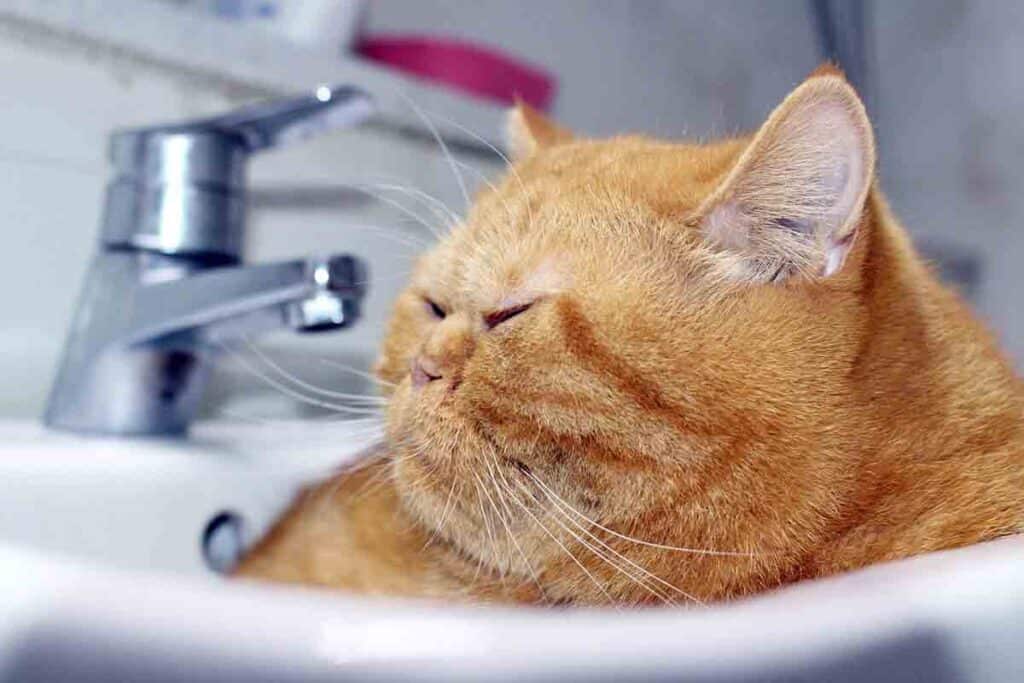
The Consequences Of Cat Obesity
Just like in people, obesity in cats is bad for their health. Obese cats are more prone to a wide range of health problems which can lead to decreased quality of life and a shortened lifespan.
Some of the potential consequences of cat obesity include:
Diabetes
Obese cats are at an increased risk of developing diabetes. This chronic illness affects the cat’s ability to metabolize glucose, and can lead to severe health problems such as blindness, urinary tract disease, and even death if left untreated.
Arthritis
Carrying extra weight can put strain on a cat’s joints, leading to painful inflammation and arthritis. This causes stiffness in the cat’s joints, making it difficult for them to move around.
Respiratory Problems
Extra fat in the abdomen can compress the lungs and chest cavity, resulting in difficulty breathing. This is particularly concerning if the cat is also suffering from asthma or other respiratory conditions.
Heart Disease
Carrying extra weight may also increase a cat’s risk of developing heart disease. This can lead to fluid retention, high blood pressure, and other cardiovascular which can be life-threatening if left untreated
Urinary Tract Problems
Obesity can lead to a number of urinary tract problems, including crystals and stones in the bladder, which can be very painful or even cause blockage. It may also cause an increase in the risk of urinary infections and kidney disease.
Skin Problems
Obese cats may have difficulty grooming themselves, which can lead to skin problems such as mats, tangles, and skin infections. These cats often appear greasy and unkempt.
Shortened Lifespan
Finally, obesity can lead to a shortened lifespan in cats. Obese cats are at an increased risk of developing chronic illnesses and even cancer, which can affect their quality of life and ultimately result in an early death.
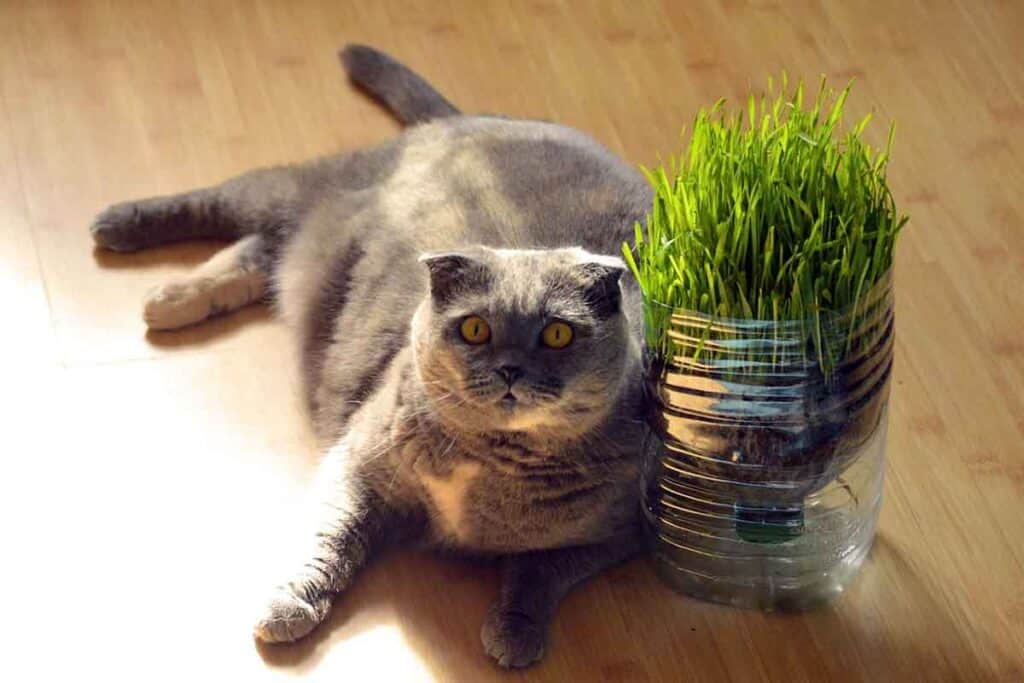
How much should my cat eat daily?
The amount of food your cat needs to eat each day will depend on several factors, including their age, weight, activity level, and overall health.
In general, cats in the ideal weight category should eat 20 to 33 calories daily for each pound that they weigh. For example, a 10 lb indoor cat that is not highly active needs about 200 calories daily, while a 10 lb outdoor cat that is very active needs about 330 calories daily.
Some cats need more calories. Nursing mothers and kittens have a higher calorie requirement than the average cat does. Cats that are underweight also need to consume additional calories until they are back at their ideal weight.
On the other hand, overweight and obese cats need fewer calories per day. This can be achieved by feeding less overall, or by choosing to feed a calorie reduced cat food.
Don’t forget to factor in the calories that are in treats. These can add up quickly and contribute to cat obesity.
It is important to consult your veterinarian if you are unsure of how much food your cat needs. They can help you come up with a tailored meal plan that meets your pet’s individual needs and helps them achieve or maintain a healthy weight.
Tips For Helping Your Cat Lose Weight
If your cat is overweight, there are several steps you can take to help them get back to their ideal weight:
- Consult with a veterinarian: Consult with a veterinarian before beginning any weight loss program for your cat. They can assist in determining your cat’s optimal weight, developing a diet plan, and tracking your cat’s progress.
- Control portion sizes: Feed your cat smaller, more frequent meals throughout the day and measure out the appropriate portion size. Avoid leaving food out all day for your cat to graze on, also known as free feeding.
- Switch to a high-protein, low-carbohydrate diet: Cats are obligate carnivores and require a diet high in protein. Search for cat food that is high in protein and of good quality while keeping carbohydrates low. Also, avoid foods that contain fillers like wheat or corn.
- Encourage exercise: To make your cat play and exercise, give them toys and schedule playtime. You can also create a play area or buy a cat tree to help them stay active. Cats love to chase laser pointers, so this is a good way to get them active. Just don’t overdo it – many cats just don’t know when to quit!
- Gradual weight loss: It’s best to focus on gradually reducing your cat’s weight, as losing weight too quickly can have negative effects on their health.
- Monitor progress: Measure their weight on a regular basis and keep track of their progress. If you observe any changes in your cat’s behavior or appetite, seek advice from your veterinarian.
- Be patient: Weight loss takes time, and it may take several months for your cat to reach their ideal weight. Be patient and consistent with your cat’s diet and exercise routine.
Conclusion
Obesity is a serious health concern for cats, as it can lead to an array of medical problems and potentially shorten their lifespan.
It is important to recognize the signs of obesity in cats and take steps to prevent it from occurring in the first place. This can involve providing a healthy, balanced diet, encouraging regular exercise, and working with a veterinarian to develop a weight loss plan if necessary.
With proper care and attention, most obese cats can achieve a healthier weight and enjoy improved quality of life.
Disclaimer: This article is intended for information purposes only, and does not constitute medical advice. Always consult your veterinarian if you have specific concerns about your pet’s health.


